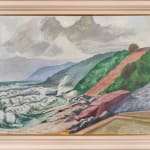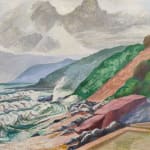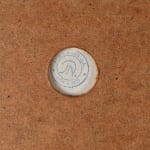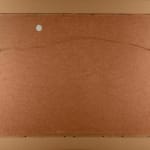John Nash
Talisker, Isle of Skye
oil on board
59.1 x 76.2 cm
23 1/4 x 30 in
23 1/4 x 30 in
Further images
Nash first visited the Isle of Skye in 1957. He continued to visit annually, staying with Barbara and John Langston at Peinmore in Portree. This work evokes the celebrated war...
Nash first visited the Isle of Skye in 1957. He continued to visit annually, staying with Barbara and John Langston at Peinmore in Portree.
This work evokes the celebrated war painting by Nash’s elder brother, Paul Nash (1889-1946), Totes Meer (Dead Sea), 1940-1, now in the Tate (reference N05717). The compositional and thematic similarities are hard to ignore between these two paintings when compared. Totes Meer (German for Dead Sea) was realised after the elder brother painted what he perceived to be a ‘sea’ of damaged aircraft in Cowley, Oxfordshire. The metal wreckage forms the crest of waves with their shadows casting their light on what seems to be a beach. Paul Nash wrote to Sir Kenneth Clark describing how, ‘The thing looked to me suddenly like a great inundating sea. You might feel - under certain influences - a moonlight night for instance - this is a vast tide moving across the fields, the breakers rearing up and crashing on the plain. And then, no: nothing moves, it is not water or even ice, it is something static and dead.... By moonlight, this waning moon, one could swear they began to move and twist and turn as they did in the air. A sort of rigor mortis? No, they are quite dead and still.’ (Letter of 11 March 1941 in Imperial War Museum files, partly reprinted in Bertram, loc. cit.)
In the present work, it is as if John Nash has reimagined his brother’s famous painting as the sea itself, and in Skye. Much like Stanley Spencer reimagined heaven to be in Cookham. Here, instead of deserted aircraft we have the sea itself – somehow frozen in motion, lapping the shores of Skye, lit by moonlight above. The message is one of hope and renewal and of the power of nature to heal and restore. The man-made structure to the right may well be an invention by Paul Nash, another homage to the surrealism of his brother, as it belies topographical accuracy. The strong orthogonals emulate the surrealism of Paul Nash and compositions such as ‘Equivalents for the Megaliths’ (1935), Landscape at Iden (1935) and the etching Promenade II (1920).
A couple of watercolour studies exist for this work, one which is squared for transfer, dates to circa 1960 and another watercolour study squared for transfer has been dated circa 1976. On close examination the present work has pencil marks of squares showing how it has been enlarged from a smaller sketch. John Nash is known to have made many watercolour sketches, not all of which were made into fuller scale paintings, and some of which were only worked up into oil at a much later date to their creation. So while it is not clear exactly when this work was painted, what does seem evident is that the painting is a reimagining and homage to the work of his elder brother, a painting of hope for the future, that speaks of nature’s ability to recover and to endure, and to overcome the devastation of war.
This work evokes the celebrated war painting by Nash’s elder brother, Paul Nash (1889-1946), Totes Meer (Dead Sea), 1940-1, now in the Tate (reference N05717). The compositional and thematic similarities are hard to ignore between these two paintings when compared. Totes Meer (German for Dead Sea) was realised after the elder brother painted what he perceived to be a ‘sea’ of damaged aircraft in Cowley, Oxfordshire. The metal wreckage forms the crest of waves with their shadows casting their light on what seems to be a beach. Paul Nash wrote to Sir Kenneth Clark describing how, ‘The thing looked to me suddenly like a great inundating sea. You might feel - under certain influences - a moonlight night for instance - this is a vast tide moving across the fields, the breakers rearing up and crashing on the plain. And then, no: nothing moves, it is not water or even ice, it is something static and dead.... By moonlight, this waning moon, one could swear they began to move and twist and turn as they did in the air. A sort of rigor mortis? No, they are quite dead and still.’ (Letter of 11 March 1941 in Imperial War Museum files, partly reprinted in Bertram, loc. cit.)
In the present work, it is as if John Nash has reimagined his brother’s famous painting as the sea itself, and in Skye. Much like Stanley Spencer reimagined heaven to be in Cookham. Here, instead of deserted aircraft we have the sea itself – somehow frozen in motion, lapping the shores of Skye, lit by moonlight above. The message is one of hope and renewal and of the power of nature to heal and restore. The man-made structure to the right may well be an invention by Paul Nash, another homage to the surrealism of his brother, as it belies topographical accuracy. The strong orthogonals emulate the surrealism of Paul Nash and compositions such as ‘Equivalents for the Megaliths’ (1935), Landscape at Iden (1935) and the etching Promenade II (1920).
A couple of watercolour studies exist for this work, one which is squared for transfer, dates to circa 1960 and another watercolour study squared for transfer has been dated circa 1976. On close examination the present work has pencil marks of squares showing how it has been enlarged from a smaller sketch. John Nash is known to have made many watercolour sketches, not all of which were made into fuller scale paintings, and some of which were only worked up into oil at a much later date to their creation. So while it is not clear exactly when this work was painted, what does seem evident is that the painting is a reimagining and homage to the work of his elder brother, a painting of hope for the future, that speaks of nature’s ability to recover and to endure, and to overcome the devastation of war.
Provenance
with Phipps and Company Ltd., 1986, where purchased byJohn Constable Esq
Exhibitions
Literature
Friend, A.,John Nash The Landscape of Love and Solace, 2020, Thames and Hudson2
of
2







